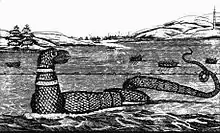Gloucester sea serpent
The Gloucester sea serpent is a creature reportedly seen around and off the coast of Gloucester, Massachusetts and Cape Ann area. The heyday of sightings began in August 1817 and continued into 1818–19. The earliest alleged sighting of such a creature off Cape Ann was recorded in 1638 by John Josselyn. Occasional sightings continued over the centuries and into the 20th century.[1][2][3][4][5][6][7][8][9][10]

The spate of 1817 sightings caused the Linnaean Society of New England to investigate. General David Humphreys visited Gloucester and interviewed witnesses. The residents of Gloucester later located a small black snake on a beach with humps, which they believed was the offspring of the serpent. The Society's analysis was published in a pamphlet which announced it was a new species which they dubbed "Scoliophis Atlanticus". However, the specimen was examined by naturalist Charles Alexandre Lesueur who determined it was only a common snake with tumors on its spine.[11]
Several witnesses had reported seeing a stinger or spear protruding from the head of the creature, which has led Joe Nickell to conclude that the creature is a narwhal.[12]

Charleston playwright William Crafts lampooned the reports of the serpent in his play The sea serpent; or, Gloucester hoax: A dramatic jeu d'esprit, in three acts, published in 1819.[2][4]
References
- Shattuck, Ben (10 August 2013). The monstrous serpent was real!, Salon
- Brown, Chandos Michael. A Natural History of the Gloucester Sea Serpent: Knowledge, Power, and the Culture of Science in Antebellum America, in American Quarterly, Vol. 42, No. 3 (Sep., 1990), pp. 402-436
- Brown, Joel (16 December 2010). Fresh look at vintage mystery, The Boston Globe
- O'Neill, J.P. The Great New England Sea Serpent: An Account of Unknown Creatures Sighted by Many Respectable Persons Between 1638 and the Present Day (2003)
- Soini, Wayne. Gloucester's Sea Serpent
- (23 August 1886). Again the Sea Serpent, The New York Times (1886 report of sighting in the New York Times)
- (2 September 1818). The Sea Serpent, The Adams Centinel (reports of August 1818 sightings reprinted in the Adams Centinel)
- Story, Alfred T. The Sea Serpent, The Strand Magazine (1895)
- Bigelow, Jacob. Documents and Remarks respecting the Sea Serpent, American Journal of Science, Vol. 2, pp. 147-49 (1820)
- (25 August 1818). The Sea Serpent, Milledgeville Reflector (sighting stories from the Salem Register and Boston Daily Advertiser)
- Costantino, Grace (27 October 2014). Five “Real” Sea Monsters Brought to Life by Early Naturalists, Smithsonian
- Nickell, Joe (2019). "Gloucester Sea-Serpent Mystery: Solved after Two Centuries". Skeptical Inquirer. 43 (5): 14–16. Retrieved 12 October 2019.
External links
- Report of a committee of the Linnaean Society of New England, relative to a large marine animal, supposed to be a serpent, seen near Cape Ann, Massachusetts, in August 1817, Linnaean Society of New England
- Lore (podcast), A Deep Fear - Episode 59 (May 1, 2017)